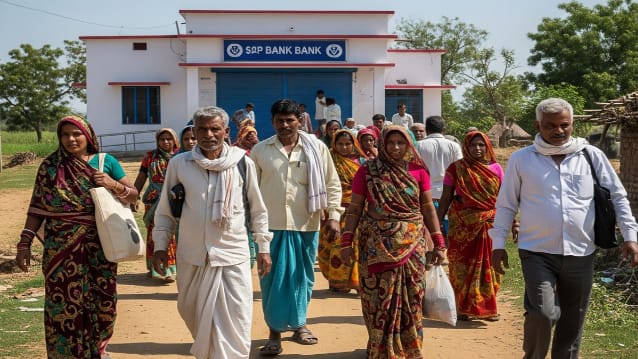By 2030, over half of India’s fintech growth will come from smaller towns and villages, driven by trust-first design and household-focused underwriting.

The Reserve Bank of India’s Financial Inclusion Index has risen from 53.9 in 2017 to 60.1 in 2023 and is expected to cross 70 by 2027. (Source: financialexpress)
A subtle and profound shift is taking place in rural India. Families once regarded as subsistence-driven are becoming entrepreneurial households, operating small enterprises, investing in education, and using digital finance tools to expand earnings and reduce risk.
This transformation is revolutionising the way banks, fintechs, and NBFCs conceptualise financial services beyond urban India. In the next five years, according to experts, the BFSI sector will be increasingly turning towards designing for these entrepreneurial households, and that direction will chart the next growth chapter of Indian finance.
The Reserve Bank of India’s Financial Inclusion Index has risen from 53.9 in 2017 to 60.1 in 2023 and is expected to cross 70 by 2027 due to increased adoption of mobile-first and embedded finance in rural districts.
Also read: AUM of ARCs May Shrink 6% in FY26 as Redemptions Outpace Acquisitions: Crisil
More than 82 per cent of rural users of the internet get access to financial products through smartphones, as per the Internet and Mobile Association of India (IMAI, 2023). Use of UPI in non-metro cities is now developing at twice the pace of metros, as per the National Payments Corporation of India.
There are still access issues for rural households to reach context-aware savings, insurance, and credit products, particularly as incomes get diversified and seasonal.
"Underwriting has to change from a personal to a household-level determination," says Jyotsna Krishnan, CEO and Co-founder of EPIC World. "Companies such as Sarvagram illustrate this by analysing the household as one economic entity, taking into account several income sources to better measure creditworthiness in sophisticated rural economies."
India’s embedded finance sector, where financial services are designed into non-bank platforms, is projected to grow to $60 billion by 2030, from $4 billion in 2023. Rural and semi-urban demand will be a big contributor to much of this growth.
Consider Varthana, a non-bank lender with a sole business purpose: education. By providing loans to low-cost private schools in neglected parts of the country, it allows for infrastructure improvements, teacher training, and increased enrollments, all with long-term social and financial returns.
"Finance needs to step more and more into the horizontal role of facilitating other core services," says Krishnan. "The specific capital that Varthana provides enables schools to enhance facilities and serve more students.”
With the growing digital finance footprint, portfolio quality worries also increase. Microfinance loan delinquencies increased to 9.5 per cent in 2024, mainly among overleveraged rural hubs, according to CRIF data. Even unsecured SME lending and small-ticket consumer loans witness the strain.
Experts caution that mere broadening of access, without aligning product design and underwriting with reality on the ground, will be detrimental to both lenders and customers.
As India's BFSI sector continues to change, three broad changes are set to rule:
Household-Focused Financial Models: Lenders will shift from individual KYC to evaluate household income stability, debt affordability, and expenditure behaviour. Technologies such as income aggregation, alternative credit scoring, and AI-driven underwriting will be key.
Finance Embedded in Everyday Platforms: Deeper embedding of credit, insurance, and savings within edtech, agritech, and healthcare platforms for Tier 2–4 markets.
Trust and Accessibility Design: With more than 500 million vernacular internet users by the year 2030, UI/UX for voice, video, and local language interfaces will be a necessity for adoption and retention.
In a jointly issued report by BCG and FICCI (2023), the fintech market in India is expected to become a $75 billion opportunity by 2030 with more than 55 per cent of fresh revenues likely to originate from non-metro markets. The expansion will be based not on mass expansion but on specialised, nuanced delivery.
India's rural economy is evolving and its attitude towards finance is changing too. As mature digital rails, mobile-first platforms, and embedded finance solutions become available, the true opportunity is not in quantity but in value creation. The BFSI players who see this transition and react with intent and intelligence will shape the next decade of India's growth narrative.
By continuing you agree to our Privacy Policy & Terms & Conditions
